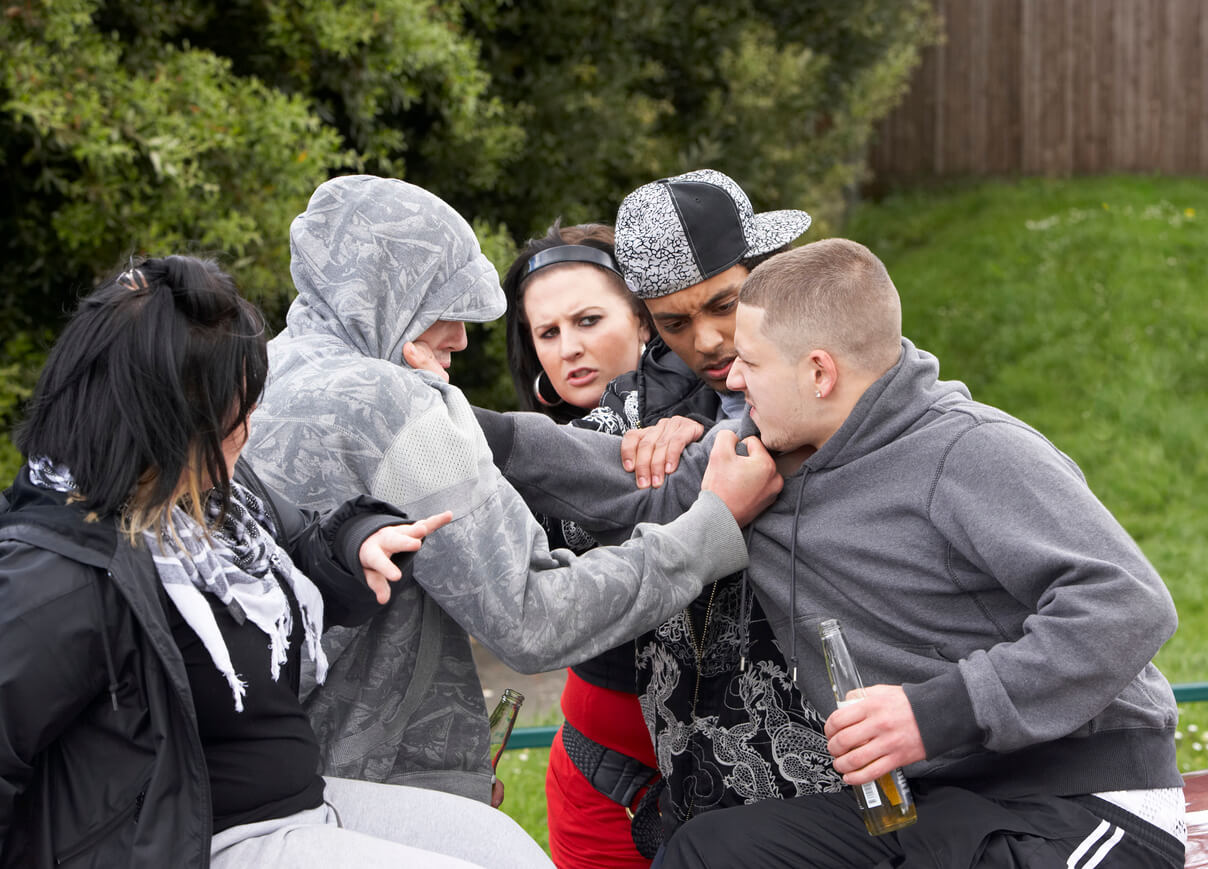The Main Psychological Problems in Adolescents


Written and verified by the psychologist Mara Amor López
The appearance of certain irregularities in the reasoning or behavior of young people is very common. The seriousness of these issues will depend on their background, especially if they have to do with a disorder. Therefore, in this article, we’re going to share with you some of the main psychological problems that occur in adolescents.
Adolescence is a complex stage of life, both for children and parents. There are many physical, social, and psychological changes that take place at this time and, often, minors tend to block dialogue with their elders and keep them from finding out what’s going on. Read on and find out what the clues that should alert you are.
Types of psychological problems in adolescence
Most psychological disorders in adolescents can be divided into two main types:
- Learning problems: Such as attention deficit with or without hyperactivity, dyslexia, and dyscalculia, among others.
- Emotional and behavioral problems: These include mood disorders, eating disorders (ED), and adolescent crises (rebelliousness, social isolation, anxiety, substance abuse disorder, among others).
What are the main psychological problems that adolescents suffer from
As we’ve mentioned, some changes in behavior or in information processing may be expected at this stage, as the adolescent brain is in the midst of development. However, some of these signs may also suggest the presence of some specific psychological problems, which usually manifest themselves in adolescence. Take note of the most frequent situations experienced by young people.
1. Stress
In adolescents, stress usually manifests itself as a mixture of anxiety and depression or as behavioral disturbances. As in adults, some children are more affected than others, which explains the wide range of symptoms.
The main symptoms of stress:
- Overeating or eating less than before
- Increased tiredness
- Nervousness
- Concentration problems
- Social isolation
- Bad mood
- Depression

Frequent causes of stress in adolescence:
- Problems fitting into their peer group
- School bullying or cyberbullying
- Lack of friends
- Frequent arguments with parents
- Breakups
- The divorce of their parents
2. Anxiety
Although it’s quite common to see young people being more anxious than children, it’s important to keep anxiety within certain limits so that it doesn’t affect them negatively. Anxious adolescents tend to be very perfectionistic and unsure of themselves and, in general, need constant approval from others. Those with this condition are often distrustful of others and fearful of various situations.
Also, there may be anxiety crises or attacks, which appear suddenly and intensely. The following symptoms are some examples of this:
- Palpitations
- Tremors
- Digestive problems
- Dizziness
- Sweating
- Chest pain
- Shortness of breath
- Feeling of dying
3. Aggressiveness
It’s common that, in adolescence, there are moments of tension and greater aggressiveness than in childhood, especially if they’ve lived in a hostile environment. It’s important that values linked to violence aren’t transmitted at home so that children and young people don’t naturalize it and replicate it in other areas.
Some causes of aggressiveness in young people may be the following:
- Mental disorders or illnesses
- A violent family environment
- Biological or neurophysiological factors
- The absence of figures of support or reference
- An unproductive educational system

4. Depression
It’s common for many adolescents to have a poor mood, as they go through many changes in a short time and must adapt at great speed. For this reason, the diagnosis of depression in young people is often difficult, although we must be very attentive to the following signs:
- A sudden increase or decrease in body weight
- Fear of dying
- Tiredness or low energy
- Sleep problems, either by excess or defect
- Low mood and increased tendency to irritability
- Loss of interest in anything they used to do or like
- Feelings of inadequacy
- Excessive agitation or slowness
- Concentration problems
5. Anorexia and bulimia
The most common eating disorders (EDs) among adolescents are anorexia and bulimia. Both are characterized by an obsessive relationship with food and weight, and even a distortion of body image. The young people most predisposed to these disorders are the most perfectionist, insecure, and controlling of their appearance.
The following symptoms can make us suspect that there’s an ED:
- Excessive fear of gaining weight or becoming obese, even if they’re underweight.
- Alteration of body image. People feel they’re overweight and see themselves as obese.
- In the case of women, if they’ve already had their first period, it may disappear for even two or three cycles in a row.
- Excessive weight control to keep it just above the expected minimum, in relation to their height and age.
Regarding the main psychological problems in adolescents…
It’s important that we detect psychological problems in adolescents as soon as possible in order to seek timely solutions together with them. Parents should show understanding, have patience, and, above all, give them the support they need.
Adolescents go through a complicated period, and the accompaniment of adults is crucial for them to live it in the best possible way. At the slightest suspicion that your child suffers from some psychological problem, it’s important to seek specialized help. This way, it’ll be possible to diagnose and treat the cause of their suffering as soon as possible.
The appearance of certain irregularities in the reasoning or behavior of young people is very common. The seriousness of these issues will depend on their background, especially if they have to do with a disorder. Therefore, in this article, we’re going to share with you some of the main psychological problems that occur in adolescents.
Adolescence is a complex stage of life, both for children and parents. There are many physical, social, and psychological changes that take place at this time and, often, minors tend to block dialogue with their elders and keep them from finding out what’s going on. Read on and find out what the clues that should alert you are.
Types of psychological problems in adolescence
Most psychological disorders in adolescents can be divided into two main types:
- Learning problems: Such as attention deficit with or without hyperactivity, dyslexia, and dyscalculia, among others.
- Emotional and behavioral problems: These include mood disorders, eating disorders (ED), and adolescent crises (rebelliousness, social isolation, anxiety, substance abuse disorder, among others).
What are the main psychological problems that adolescents suffer from
As we’ve mentioned, some changes in behavior or in information processing may be expected at this stage, as the adolescent brain is in the midst of development. However, some of these signs may also suggest the presence of some specific psychological problems, which usually manifest themselves in adolescence. Take note of the most frequent situations experienced by young people.
1. Stress
In adolescents, stress usually manifests itself as a mixture of anxiety and depression or as behavioral disturbances. As in adults, some children are more affected than others, which explains the wide range of symptoms.
The main symptoms of stress:
- Overeating or eating less than before
- Increased tiredness
- Nervousness
- Concentration problems
- Social isolation
- Bad mood
- Depression

Frequent causes of stress in adolescence:
- Problems fitting into their peer group
- School bullying or cyberbullying
- Lack of friends
- Frequent arguments with parents
- Breakups
- The divorce of their parents
2. Anxiety
Although it’s quite common to see young people being more anxious than children, it’s important to keep anxiety within certain limits so that it doesn’t affect them negatively. Anxious adolescents tend to be very perfectionistic and unsure of themselves and, in general, need constant approval from others. Those with this condition are often distrustful of others and fearful of various situations.
Also, there may be anxiety crises or attacks, which appear suddenly and intensely. The following symptoms are some examples of this:
- Palpitations
- Tremors
- Digestive problems
- Dizziness
- Sweating
- Chest pain
- Shortness of breath
- Feeling of dying
3. Aggressiveness
It’s common that, in adolescence, there are moments of tension and greater aggressiveness than in childhood, especially if they’ve lived in a hostile environment. It’s important that values linked to violence aren’t transmitted at home so that children and young people don’t naturalize it and replicate it in other areas.
Some causes of aggressiveness in young people may be the following:
- Mental disorders or illnesses
- A violent family environment
- Biological or neurophysiological factors
- The absence of figures of support or reference
- An unproductive educational system

4. Depression
It’s common for many adolescents to have a poor mood, as they go through many changes in a short time and must adapt at great speed. For this reason, the diagnosis of depression in young people is often difficult, although we must be very attentive to the following signs:
- A sudden increase or decrease in body weight
- Fear of dying
- Tiredness or low energy
- Sleep problems, either by excess or defect
- Low mood and increased tendency to irritability
- Loss of interest in anything they used to do or like
- Feelings of inadequacy
- Excessive agitation or slowness
- Concentration problems
5. Anorexia and bulimia
The most common eating disorders (EDs) among adolescents are anorexia and bulimia. Both are characterized by an obsessive relationship with food and weight, and even a distortion of body image. The young people most predisposed to these disorders are the most perfectionist, insecure, and controlling of their appearance.
The following symptoms can make us suspect that there’s an ED:
- Excessive fear of gaining weight or becoming obese, even if they’re underweight.
- Alteration of body image. People feel they’re overweight and see themselves as obese.
- In the case of women, if they’ve already had their first period, it may disappear for even two or three cycles in a row.
- Excessive weight control to keep it just above the expected minimum, in relation to their height and age.
Regarding the main psychological problems in adolescents…
It’s important that we detect psychological problems in adolescents as soon as possible in order to seek timely solutions together with them. Parents should show understanding, have patience, and, above all, give them the support they need.
Adolescents go through a complicated period, and the accompaniment of adults is crucial for them to live it in the best possible way. At the slightest suspicion that your child suffers from some psychological problem, it’s important to seek specialized help. This way, it’ll be possible to diagnose and treat the cause of their suffering as soon as possible.
All cited sources were thoroughly reviewed by our team to ensure their quality, reliability, currency, and validity. The bibliography of this article was considered reliable and of academic or scientific accuracy.
- Herrera Santi, P. (1999). Principales factores de riesgo psicológicos y sociales en el adolescente. Revista cubana de Pediatría, 71(1), 39-42.
- Ocampo, D. B., & Palos, P. A. (2011). Control parental y problemas emocionales y de conducta en adolescentes. Revista colombiana de psicología, 20(1), 27-41.
- Espada, J. P., Méndez, X., Griffin, K., & Botvin, G. J. (2003). Adolescencia: consumo de alcohol y otras drogas. Papeles del psicólogo, 84(23), 9-17.
- Gallegos, W. L. A. (2013). Agresión y violencia en la adolescencia: la importancia de la familia. Avances en psicología, 21(1), 23-34.
This text is provided for informational purposes only and does not replace consultation with a professional. If in doubt, consult your specialist.








